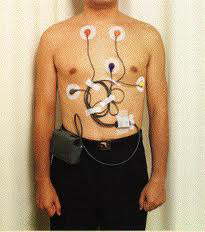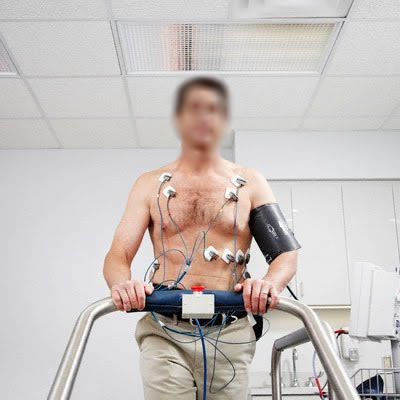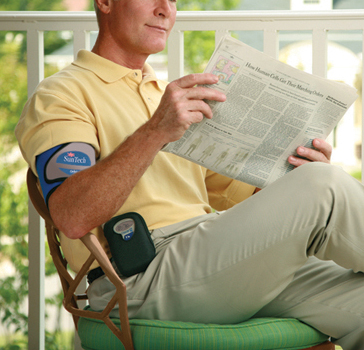

24-hour ECG holter monitoring is continuous tape recording of a patient's ECG for 24 hours, during regular daily activities. It's simple painless noninvasive procedure. Electrodes attached to the chest records electrical signals from the heart to the portable device. When the recording of ECG signal is finished (usually after 24 hours), it is up to the physician to perform the signal analysis.While normal ECG records only 0.025%of heart activity ECG holter is much more likely to detect an abnormal heart rhythm since the record covers 24 hours. It can also help evaluate the patient's ECG during episodes of chest pain, during which time there may be changes to suggest ischemia.
REMEMBER!!
- Persons being monitored should have normal daily activities: all kinds of movement, work, climbing stairs, eating, sleeping.
- It is important to record in the diary any symptoms of chest pain, shortness of breath, palpitations, skipped heartbeats, dizziness, fear.
- Register these symptoms and when they show up you will push a button on the event monitor recorder.
- Keep the electrodes attached to your skin.
- Don't play with the recorder.
- Keep the electrodes and monitor dry (Do not take a shower or bath, or go swimming).
Persons being monitored should not limit normal daily activities, since its purpose is to record how a heart works under various actual conditions over an extended period. It is an electrical device, however, and should be kept dry; showering or swimming should probably be avoided.

Avoiding using electric blankets during the procedure, since they can also create electrical interference on the recording tape.
At the end of the procedure, you will return to the physician's office to have the electrodes removed and the monitor discontinued and you'll turn in the diary you kept while you wore the Holter monitor.
When the Holter monitor is interpreted, your doctor will compare data from the recorder and the activities and symptoms you wrote down. Then the data are uploaded into a computer which then automatically analyzes the input, counting ECG complexes, calculating summary statistics such as average heart rate, minimum and maximum heart rate, different sort of heart beats, rhythms, etc.
After your doctor has looked at the results of the Holter monitor recorder and what you've written in your activity diary, he/ she will talk to you about your results or even compare to your previous results from your medical history. The information from the Holter monitor may reveal that you have a heart condition, and your doctor may be able to diagnose your condition and give best treatment.

Cardiac stress test is extremely important diagnostic and prognostic procedure used to determine coronary artery blockages in patients with symptoms or signs that are suggestive of coronary artery diseases (CAD). It shows the oxygen demand, carbon dioxide production and ventilator parameters if using flow-meter. Volume myocardial oxygen consumption is 3.5ml/min/kg which is equal to 1 MET(metabolic equivalent).
The patient exercises on a treadmill according to a standardized Bruce protocol, with progressive increases in the speed and elevation of the treadmill (typically changing at three minute intervals). During thetest, the patient's electrocardiogram (EKG), heart rate, heart rhythm, and blood pressure are continuously monitored. Before doing the test patient should know some recommendations such as:
- Avoid doing test if you have flue like symptoms in the past few weeks.
- Specific regular heart medication should not be discontinued even on the test day.
- 2-3 hours prior to test take light meal, but don't drink beverages containing caffeine or alcohol.
- Wear comfortable clothing and shoes that are suitable for exercise.
- Take all your medical documentation

Ambulatory blood pressure monitoring is diagnostic method for continuous measurement of blood pressure. This method offers data about circadian rhythm-biological rhythm of the blood pressure during 24hours. This allows evaluation of the efficacy of a medication on your blood pressure during your daily routine, making decisions about your ongoing treatment strategy such as adjusting dosages or changing medications help make an early diagnosis of high blood pressure. A standard blood pressure cuff will be placed just above the elbow on your non-dominant arm. The ABP monitor is the size of a small walkman and can be placed in a pouch so it may be slung across your shoulder. The monitor will be set to inflate every 30 minutes during the day and every 60 minutes during your sleeping hours.
Try to keep your arm as still as possible during the reading or the cuff will inflate again until a correct reading is taken. An event diary will also be given to you to record the time of all activities, medications or events such as light headedness. The monitor is not water-resistant, so no showers or baths can be taken during the recording. When you do return to us the following day, the completed event diary will be taken and the cuff easily removed. It is important to remember that home monitoring doesn't interfere with your daily activities.
It is important to remember that home monitoring doesn't interfere with your daily activities.

